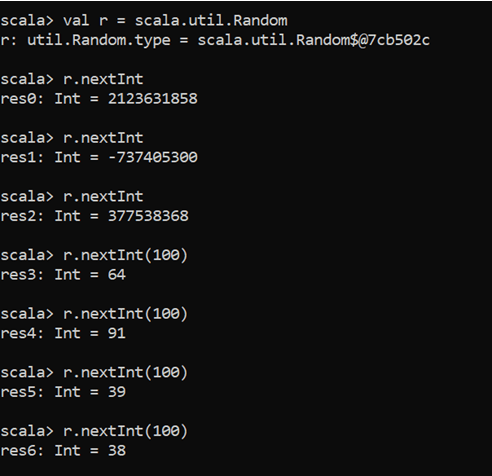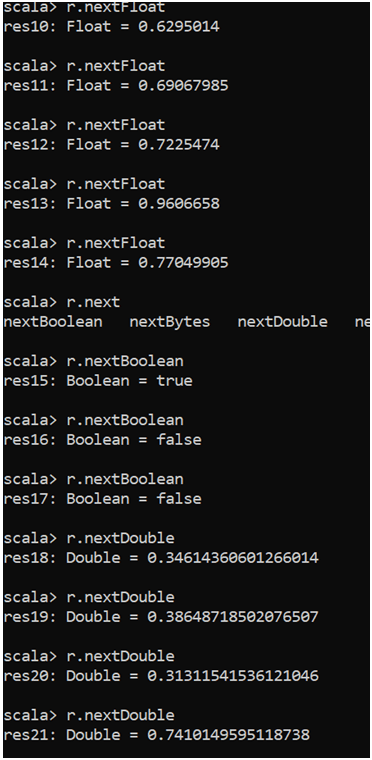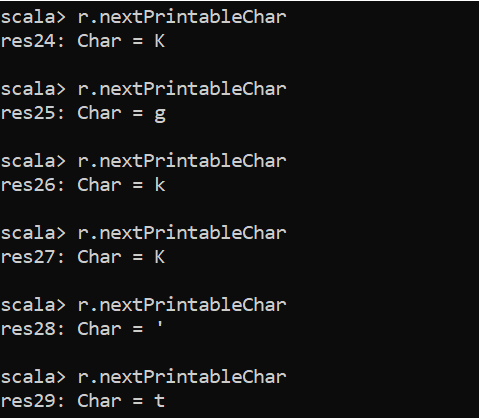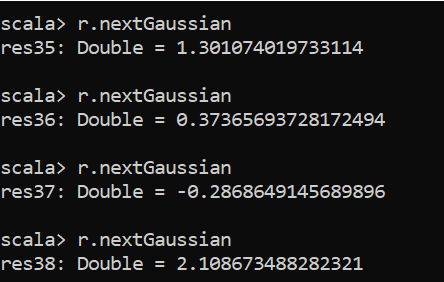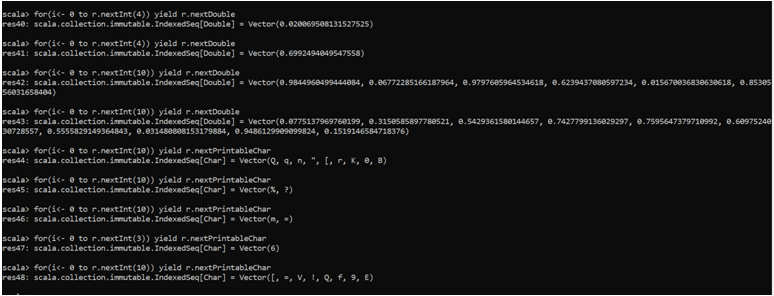Updated May 29, 2023

Introduction to Scala Random
The Scala Random function generates random numbers or characters in Scala. To generate the Random numbers over Scala, we use the Random process with Scala.util.Random class. The Random number generated can be anything,, be it Integer, Float, Double, or Char. This random no is important for various-level applications such as Validation. So it is used for the Random numbers generation in our Scala Application.
Syntax:
The application generates random numbers using Scala.util.Random class. We need to import the class, and the methods like nextInt, and nextFloat to generate the numbers.
val r = scala.util.Random
r: util.Random.type = scala.util.Random$@7889a1ac
r.nextInt
res1: Int = 1825881164
r.nextInt(100)
res2: Int = 99
r.nextFloat
res3: Float = 0.10983747Working of Scala Random with Examples
This function takes up the random function to generate numbers for processing; it generally uses the Linear congruential generator; this algorithm works on choosing the random number. We can also select the range over which we want to generate the number over. We will see the random number generation with some examples.
Example #1
Code:
val r = scala.util.Random
r: util.Random.type = scala.util.Random$@7889a1ac
r.nextInt
res0: Int = 2123631858
r.nextInt
res1: Int = -737405300
r.nextInt
res2: Int = 377538368Every Time the code is run or this function is called we will get the set of different values in the usual pattern without following any rule or pattern. Even we can also set an inclusive as well as an exclusive limit for the random number we want to generate.
Note: By default, the inclusive limit is 0 so we can also set only the exclusive one.
r.nextInt(100)
res3: Int = 64
r.nextInt(100)
res4: Int = 91
r.nextInt(100)
res5: Int = 39
r.nextInt(100)
res6: Int = 38Output:
Example #2
We can also select the Random Float value by the method NextFloat.So the range will lie from 0.0 decimal value to 1. Let us check that with some example:
Code:
r.nextFloat
res8: Float = 0.59556204
r.nextFloat
res9: Float = 0.8322488
r.nextFloat
res10: Float = 0.6295014
r.nextFloat
res11: Float = 0.69067985
r.nextFloat
res12: Float = 0.7225474
r.nextFloat
res13: Float = 0.9606658
r.nextFloat
res14: Float = 0.77049905Same as Float we can also create random numbers for Double Values.
r.nextDouble
res18: Double = 0.34614360601266014
r.nextDouble
res19: Double = 0.38648718502076507
r.nextDouble
res20: Double = 0.31311541536121046
r.nextDouble
res21: Double = 0.7410149595118738It also prints the values between 0 to 1. The Boolean value can also use the same Random value and yields result based on Boolean Values.
r.nextBoolean
res15: Boolean = true
r.nextBoolean
res16: Boolean = false
r.nextBoolean
res17: Boolean = falseOutput:
Example #3
Even the Scala Random function is used to generate the characters also Randomly. We can use the method nextprintableChar from the Random class method and generates characters accordingly. Let us check that with Example:
Code:
r.nextPrintableChar
res24: Char = K
r.nextPrintableChar
res25: Char = g
r.nextPrintableChar
res26: Char = k
r.nextPrintableChar
res27: Char = K
r.nextPrintableChar
res28: Char = '
r.nextPrintableChar
res29: Char = tSo it prints all the CharatcersRandomly. It is possible that the same character or integer value can come many times; there is no rule for the numbers not to be repeated.
Note: This Random function is widely used for Pattern Verification, security applications like Captcha, and other things.
Output:
Example #4
We can also use the Random function over a distribution. One known function that works with it is the Gaussian function. The Gaussian Function takes the Random data over the Gaussian Distribution and prints data accordingly. It returns a random number with a mean of 0 and a deviation of 1. To change this Gaussian value, we need to provide that explicitly.
Code:
r.nextGaussian
res35: Double = 1.301074019733114
r.nextGaussian
res36: Double = 0.37365693728172494
r.nextGaussian
res37: Double = -0.2868649145689896
r.nextGaussian
res38: Double = 2.108673488282321Output:
This is what it generates randomly over a Gaussian Distribution.
Example #5
We can also merge random functions and create a List or store them in the collection we want. Let us check that with Example:
Code:
for(i<- 0 to r.nextInt(4)) yield r.nextDouble
res40: scala.collection.immutable.IndexedSeq[Double] = Vector(0.020069508131527525)
for(i<- 0 to r.nextInt(4)) yield r.nextDouble
res41: scala.collection.immutable.IndexedSeq[Double] = Vector(0.6992494049547558)
for(i<- 0 to r.nextInt(10)) yield r.nextDouble
res42: scala.collection.immutable.IndexedSeq[Double] = Vector(0.9844960499444084, 0.06772285166187964, 0.9797605964534618, 0.6239437080597234, 0.015670036830630618, 0.8530556031658404)
for(i<- 0 to r.nextInt(10)) yield r.nextDouble
res43: scala.collection.immutable.IndexedSeq[Double] = Vector(0.0775137969760199, 0.3150585897780521, 0.5429361580144657, 0.7427799136029297, 0.7595647379710992, 0.6097524030728557, 0.5555829149364843, 0.031480808153179884, 0.9486129909099824, 0.1519146584718376)
for(i<- 0 to r.nextInt(10)) yield r.nextPrintableChar
res44: scala.collection.immutable.IndexedSeq[Char] = Vector(Q, q, n, ", [, r, K, 0, B)
for(i<- 0 to r.nextInt(10)) yield r.nextPrintableChar
res45: scala.collection.immutable.IndexedSeq[Char] = Vector(%, ?)
for(i<- 0 to r.nextInt(10)) yield r.nextPrintableChar
res46: scala.collection.immutable.IndexedSeq[Char] = Vector(m, =)
for(i<- 0 to r.nextInt(3)) yield r.nextPrintableChar
res47: scala.collection.immutable.IndexedSeq[Char] = Vector(6)
for(i<- 0 to r.nextInt(10)) yield r.nextPrintableChar
res48: scala.collection.immutable.IndexedSeq[Char] = Vector([, =, V, !, Q, f, 9, E)Here we can see how we merged the different functions of Random and generated results accordingly.
Output:
As a result, this function is used to generate random values throughout the Scala application that may be required repeatedly.
Conclusion
From the above article, we saw how we could use the Scala Random function to generate random values and use it over the Scala Application. We also saw the various type by which we can create a random number. So it is a very good and important method used in Scala Programming for various Scala works.
Recommended Articles
We hope that this EDUCBA information on “Scala Random” was beneficial to you. You can view EDUCBA’s recommended articles for more information.
